Janice Hardy's Blog, page 15
October 29, 2021
The Spouse's Guide to NaNoWriMo: Juggling Life and Writing in November
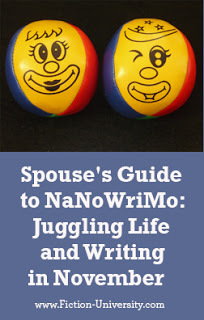 By Thomas Hardy
By Thomas HardyJH: Here's some advice on how the non-writers in your life can help you manage NaNo.
Ah, November. The thrill of Halloween is fading. A chill is in the air. Autumn leaves are putting on their best displays of the year. Pumpkin spice is in the air. And every writer I know is suddenly offline, uncommunicative and hard to find.
Yes folks, it’s NaNo time. National Novel Writing Month is here and the Starbucks gatherings sound like a herd of mice in tap shoes.
I’m married to an author. NaNo has been part of our holiday cycle for a lot of years now. It’s a period where she is doing her best to focus and make it the most productive 30 days of the year. That takes a big commitment from her and as hard as it is, it can be just as tough on a spouse. So here are a few thoughts to help you get through it together.
Continue ReadingWritten by Janice Hardy. Fiction-University.com
Published on October 29, 2021 04:05
October 28, 2021
Follow the White Rabbit: A Pantser���s Tale
 By Patricia A. Jackson, @Treistan
By Patricia A. Jackson, @Treistan Part of the How They Do It Series
JH: Every writer has their own process. Patricia��A. Jackson shares how she follows her pantser heart.
Patricia A. Jackson is a high school Language Arts teacher in Pennsylvania. Her debut novel, Forging A Nightmare , an urban fantasy, is due out November 2021 from Angry Robot Books.
She has also published a number of short stories in the Star Wars Universe for the WestEnd Games quarterly Star Wars Adventure Journal. Her best known works are Black Sands of Socorro, a smugglers��� sourcebook about people of color for Star Wars: The Role-Playing Game, and The Final Exit, a short story about a dark Jedi���s redemption.
When not writing, she���s gaming. Her favorite pastimes being Witcher III, Dragon Age, and Mass Effect. If she���s not grading an endless pile of flash fiction from students, Patricia runs a Dungeons & Dragons club at her high school to promote the next generation of players, writes fanfiction for her favorite Japanese anime, Psycho Pass, and rides show horses in hunter/jumper competition.Website | Goodreads | Facebook | Twitter | Instagram
Take it away Patricia���
Continue ReadingWritten by Janice Hardy. Fiction-University.com
Published on October 28, 2021 05:33
Follow the White Rabbit: A Pantser’s Tale
 By Patricia A. Jackson, @Treistan
By Patricia A. Jackson, @Treistan Part of the How They Do It Series
JH: Every writer has their own process. Patricia A. Jackson shares how she follows her pantser heart.
Patricia A. Jackson is a high school Language Arts teacher in Pennsylvania. Her debut novel, Forging A Nightmare , an urban fantasy, is due out November 2021 from Angry Robot Books.
She has also published a number of short stories in the Star Wars Universe for the WestEnd Games quarterly Star Wars Adventure Journal. Her best known works are Black Sands of Socorro, a smugglers’ sourcebook about people of color for Star Wars: The Role-Playing Game, and The Final Exit, a short story about a dark Jedi’s redemption.
When not writing, she’s gaming. Her favorite pastimes being Witcher III, Dragon Age, and Mass Effect. If she’s not grading an endless pile of flash fiction from students, Patricia runs a Dungeons & Dragons club at her high school to promote the next generation of players, writes fanfiction for her favorite Japanese anime, Psycho Pass, and rides show horses in hunter/jumper competition.Website | Goodreads | Facebook | Twitter | Instagram
Take it away Patricia…
Continue ReadingWritten by Janice Hardy. Fiction-University.com
Published on October 28, 2021 05:33
October 27, 2021
5 Tips for Scoring More Book Reviews
 By Veronica Mixon
By Veronica Mixon
Part of The Indie Author Series
JH: Reviews can make or break a book. Veronica Mixon shares tips on how to encourage more reviews.
Veronica’s just a Florida girl living in a Georgia world. More specifically, in Savannah’s Low Country, where if your ancestry doesn’t go back four-generations you’re tagged as a TT (temporary transplant).
She began storytelling at a young age, somewhere around three, when a host of imaginary friends lived in her bedroom closet and encouraged her penchant for spinning tales. A career in marketing, twenty years of world travel, and a large and boisterous family supply her with ample material for the mysteries she loves to write. She lives on the Georgia coast with her husband and her nine-year-old Standard Poodle, Jasper.
Website | Goodreads | Instagram | YouTube
Take it away Veronica…
Continue ReadingWritten by Janice Hardy. Fiction-University.com
Published on October 27, 2021 05:26
October 22, 2021
NaNoWriMo Prep: Planning Your Novel���s Ending
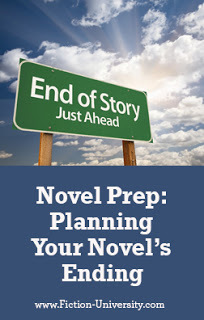 By Janice Hardy, @Janice_Hardy
By Janice Hardy, @Janice_Hardy We now come to the final installment of the annual NaNo prep articles. Hope everyone going for the 50,000 words in November are just about ready to go!
Getting to ���The End��� of a novel is pretty satisfying, both as a reader and a writer, but there���s a lot more pressure to get there for the writer. There are many things that need to happen--plots and subplots to wrap up, and those pesky character arcs to fulfill. And then there���s the whole ���satisfying resolution��� to worry about.
The ending is the last 25% of the novel, so for the NaNo folks, to meet your 50,000-word goal, that's another 12,500 words. At least one of those final chapters is going to be your wrap up, though that can be a much smaller chapter. There���s a good chance that you won���t know all the specifics about your ending in the planning stage, so don���t worry. Ideas and situations will develop over the course of the novel that will help you flesh the ending out. Even if you do know exactly how the ending will unfold, you might find deeper meanings or ways to make it resonate more once that first draft is written.
Continue ReadingWritten by Janice Hardy. Fiction-University.com
Published on October 22, 2021 03:00
October 21, 2021
A Few Foundations of Fear in Fiction
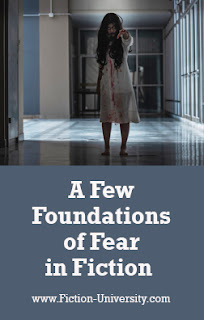 By Bonnie Randall
By Bonnie RandallPart of The How They Do It Series
JH: A lot of skill goes into making stories scary. Bonnie Randall shares five ways to put the fear into your fiction.
It’s that season again! Fears, frights, and bumps-in-the-night. If you’re like me, you’ve saved every scary book on your TBR list all year till finally you could crack the spine on October 1st. Or, if you’re really like me, you’re in the mood to brainstorm creepy plots and supernatural situations that could coalesce into a sensationally scary story of your own.
But what makes things frightening—and why the heck do we enjoy being scared in the first place? Isn’t that whole notion counterintuitive?
Yes…and no.
Continue ReadingWritten by Janice Hardy. Fiction-University.com
Published on October 21, 2021 03:00
October 15, 2021
NaNoWriMo Prep: Planning Your Novel���s Middle
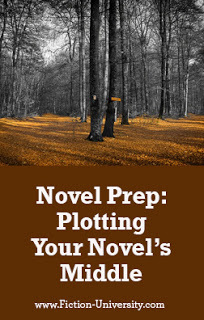 By Janice Hardy, @Janice_Hardy
By Janice Hardy, @Janice_Hardy Continuing with the annual NaNo prep posts...we dive into the turning points and problems of writing your novel's middle.
Middles might be the most common tough spot for writers, and with good reason. The middle makes up half the novel, and it���s where all the heavy plot workings happen. We usually have a decent idea of how our stories start, and roughly how they end, but that middle? What do we put in there? That often eludes us.
This is when a lot of novels start to bog down, so there���s a good chance many NaNo writers will stumble here. But don���t worry, because I know a great trick to overcome middle woes. The Mid-Point Reversal!
This is a major event that happens in the middle of your novel that helps bridge the gap between the end of the beginning and the beginning of the end (act one and act three for those using the Three Act Structure). It effectively breaks your three acts into four acts, making each section a little easier to manage.
Continue ReadingWritten by Janice Hardy. Fiction-University.com
Published on October 15, 2021 03:00
October 14, 2021
The Importance of Commas, Meter, and Reading Aloud for the Fiction Writer
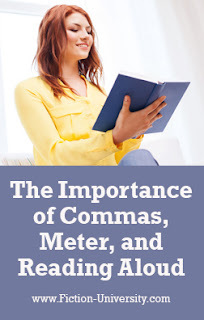 By Dario Ciriello, @Dario_Ciriello
By Dario Ciriello, @Dario_Ciriello Part of the How They Do It Series
JH: How your writing sounds is just as important as how it reads. Dario Ciriello discusses how rhythm and meter work to create memorable writing.
I recently completed an edit for a client, Cordia Pearson1, whom I’d gently persuaded to let me introduce Oxford commas into her list phrases. The reasoning for this is that using the Oxford (aka serial) comma never does any harm, and can prevent serious confusion. Consider the sentence,
My parents, Jesus, and Lady Gaga taught me all I know.If you remove the serial comma after Jesus, the meaning changes, and not for the better.
Continue ReadingWritten by Janice Hardy. Fiction-University.com
Published on October 14, 2021 03:00
October 13, 2021
Writers: How to Tell the Future
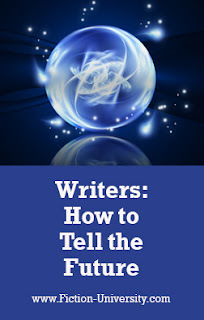 By R.W. W. Greene, @rwwgreene
By R.W. W. Greene, @rwwgreene Part of the How They Do It Series
JH: One of science fiction’s strengths is showing future possibilities and what life might be like in them. R.W.W. Greene shares tips on how to create plausible (and intriguing) futures.
R.W. W. Greene is the author of The Light Years and Twenty-Five to Life , on bookshelves now via Angry Robot Books. He is represented by Sara Megibow of the KT Literary Agency.
Website | Goodreads | Twitter | Instagram
Take it away RWW…
Continue ReadingWritten by Janice Hardy. Fiction-University.com
Published on October 13, 2021 06:08
October 12, 2021
13 Tips for Writing a Halloween Story
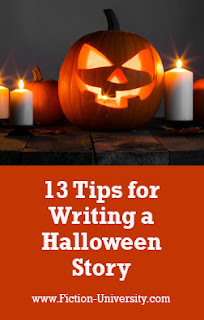 By Rayne Hall, @RayneHall
By Rayne Hall, @RayneHallPart of the Focus on Short Fiction Series
JH: Drawing inspiration from holidays is a great way to spark a new story. Rayne Hall shares 13 tips for writing a Halloween tale.
A Halloween story has two characteristics: it must unfold on or around the time of Halloween, and it must be scary in some way. Here are some ideas and tips for creating your own scary Halloween story.
1. The story features a Halloween ritual – but not necessarily a predictable one.
The story plot needs to involve Halloween customs or rituals. However, these don't need to be the conventional trick-or-treating, carved pumpkins and fancy-dress costumes. Consider the seasonal traditions of other cultures, regions and religions and draw on them for inspiration.
Continue ReadingWritten by Janice Hardy. Fiction-University.com
Published on October 12, 2021 05:13



